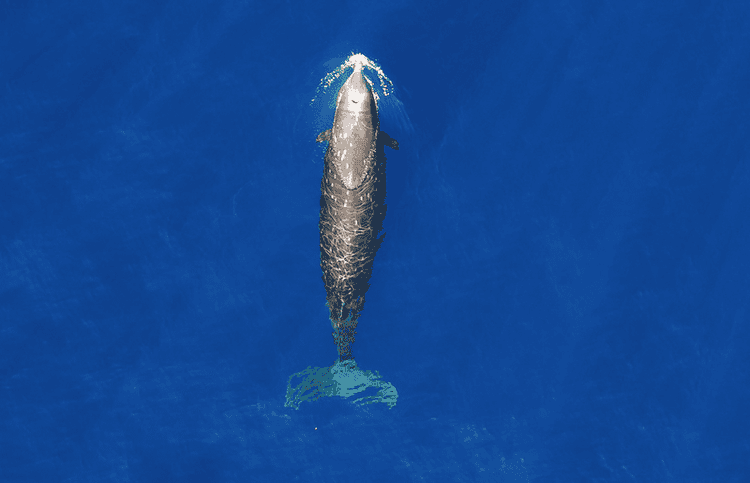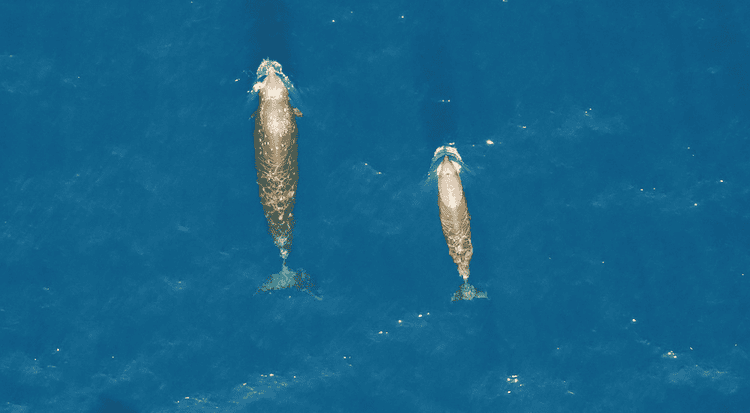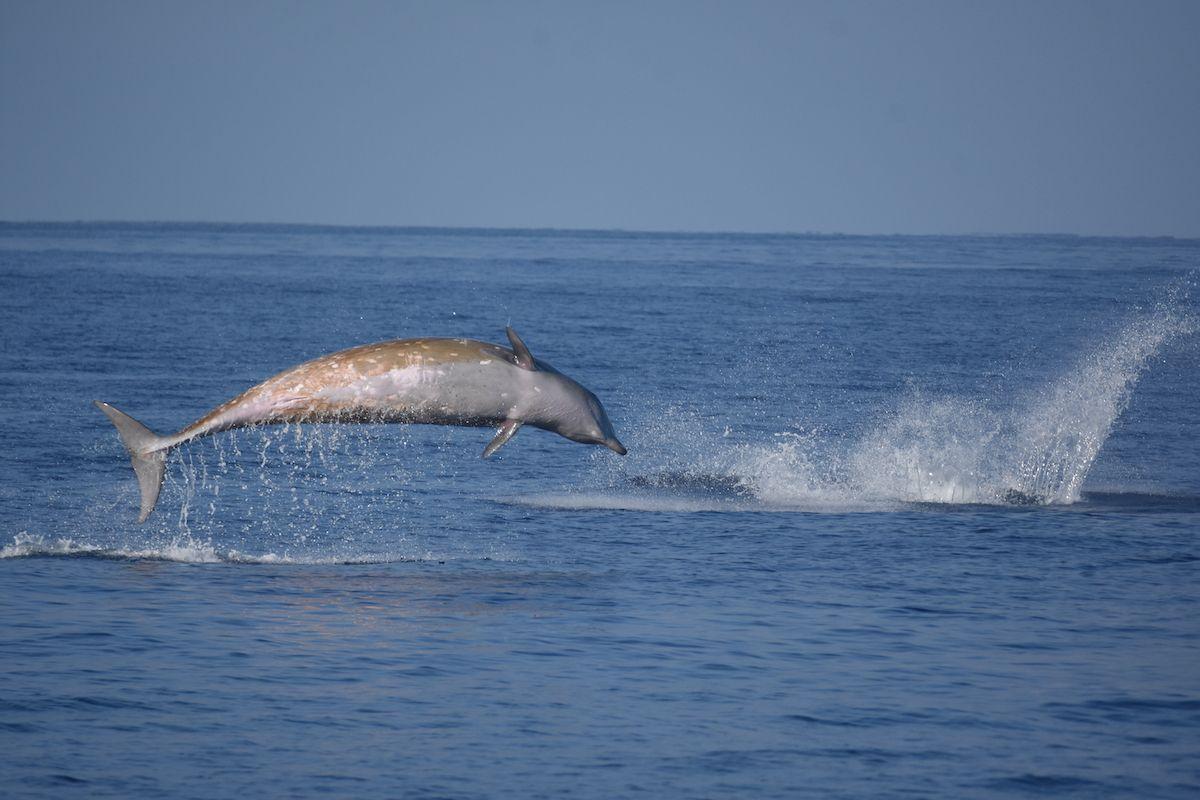The island of Guadalupe in Mexico has been at the forefront of global studies to understand how the noise pollution generated by ships affects marine mammals. The results have resulted in authorities restricting the use of sound emitters that affect the population of Cuvier's beaked whales.
Dr. Gustavo Cárdenas, leader of the “Research Project for the Zyffid of Cuvier and other cetaceans of Guadalupe Island” of the National Commission for Protected Natural Areas (Conanp), has been involved for more than a decade in the study of these cetaceans of an average size of six meters and 40 years of life; their characteristics make them closer to a dolphin than to whales.
The global disruption caused by the Covid-19 pandemic was, paradoxically, an opportunity for Cárdenas and his collaborators to have the ideal conditions to study the sounds of Cuvier's Zyphos that reside in the Guadalupe Island Biosphere Reserve, a protected marine area in Baja California.
Zyphios communicate through high-frequency sounds called “clicks” that serve a variety of purposes, such as navigating, locating their prey and stunning them once they are about to engulf them.
Although sound is vital for these animals, the noise pollution generated by ships disturbs them. The acoustical studies of the researchers discovered the disturbances caused by so-called ultrasonic antifouling systems in this species.

Photo: Jasivi Arcos Díaz.
These are high-frequency acoustic waves emitted at the bottom of the ship (submerged in water) to prevent algae and other marine organisms from adhering to the boat's hull to prevent a decrease in the ship's propulsion efficiency.
“Coating ship hulls with antifouling paints is the most common thing, but the problem is that they discovered that many of these chemicals they use in this paint were very polluting to the ocean. So as a modern solution to this problem, these ultrasonic anti-fouling systems or devices emerged,” said Cárdenas.
“(The device) has a transducer that works with electricity and what it does is vibrate to produce sound in the boat's hull... with the vibration they emit at a very high frequency, they prevent marine flora or fauna from sticking to the ship's hull and that prevents the ship from ceasing to be hydrodynamic,” Cárdenas explained.
The researchers realized that many advertisements for ultrasonic anti-fouling devices are advertised as an ecofriendly solution, with no studies to support the safety of these devices to the environment.
“The problem is that ultrasound is just at the same frequency for some of our whales that can hear these sounds,” said biological oceanographer Simone Baumann-Pickering of the Scripts Institute of Oceanography, who emphasized that whales are a species sensitive to sound.
Conanp, together with the Whale Acoustic Laboratory of the Scripts Institute of Oceanography, the organizations Marine Ecology and Telemetry Research and Sea Shepherd, began passive acoustic monitoring in 2018 by placing acoustic recording equipment on the seabed capable of detecting sounds between 10 hertz and 100 kilohertz.
The researcher explains that recording these sounds provides researchers with information to know if they are searching for their prey on the island and if the population of zyphios is present every month of the year round. By collecting photographs of the specimens, they know that Cuvier's population of Ziphios is resident and that they use the island's North Bay as a breeding space.

Mother with a calf. Photo: Jasivi Arcos Díaz.
“The hydrophone that was placed in the North Bay of the island and not only acoustically detects cetaceans, but also all the sounds of the environment, including those produced by human activities,” Cárdenas explained.
New contribution to science
The study revealed that acoustic encounters with zyphios declined between July and November 2019, which coincided with the constant use of ultrasonic anti-fouling devices by some tourist boats in the island's North Bay, dedicated to the sighting of white sharks.
“They simply stopped making sounds to look for food or they moved (displaced) and this is a disturbance and it's serious, it shouldn't happen. In other words, the animals are in their natural habitat and that bay is where we most register mothers with young, it is an area that is protected from wind and wave conditions and perhaps they use it for breeding activities,” Cárdenas explained.
In 2020, in the midst of the pandemic and without the presence of these vessels that use ultrasonic anti-fouling devices, this fall did not occur, indicating that the disturbances to the Zyfios were caused by the sounds of these devices.
Without tourist boats, cetacean specimens began to be located throughout the North Bay of the island and not only in the southeast as when they were moving away from the boats, according to the study “Ultrasonic antifouling devices negatively impact Cuvier's whale around the island of Guadalupe, Mexico”, published in the Nature portal on September 22, 2022.
The problem with travel is to assume that these whales will be able to find the same resources elsewhere, said Baumann-Pickering, also author of this study.
“In our particular case, I don't think the whales are experiencing damage to their hearing organs, in this particular case they are being displaced from their favorite habitat due to this occurrence of noise. Displacement is something we don't want to happen in a Marine Protected Area, that's for sure. But displacement per se isn't necessarily horrible at the species level if you have animals that can be moved to another location, if that other location has resources in abundance as good as they had before, and it shouldn't be a problem. But that assumption isn't so clear, is it? , that there are, in fact, equivalent resources elsewhere,” said Baumann-Pickering.

Photo: Gustavo Cárdenas Hinojosa.
From a management perspective, the researcher emphasized that the number of times a species is subjected to noise influences the impact. Once, he said, it may not create major disturbances, but persistent noise can increase the stress levels of zyphios, opening up possible scenarios affecting their health and reproductive problems.
Ultrasonic anti-fouling devices can be installed on small boats, as happened on Guadalupe Island, but also on large ships, such as cruise ships sailing elsewhere, Baumann-Pickering explained.
“Mexican ports are very attractive to a variety of cruise companies, and that in itself is worrying, because some cruise ships enter protected areas,” said the researcher.
Cárdenas added that cruise ships don't arrive in the Upper Gulf of California. But in other tourist parts of the Gulf of California, such as Loreto, La Paz or Los Cabos, cruise ships that probably use such devices arrive.
“In the article, we document that some cruise ships that arrive at the port of Ensenada do use the devices,” said Cárdenas.
Letters in the subject
Baumann-Pickering applauded the government's speed in taking action on Guadalupe Island. The findings on noise pollution from this research led Conanp to take preventive measures as part of the update of the marine protected area management program.
“As the management program was being updated, information was included on all types of fauna and all the studies that have been carried out are explored, precisely to take regulatory measures,” said Cárdenas.
Photo: Daniel Martínez.
In the update published on January 9 in the Official Gazette of the Federation, it was established that vessels that have ultrasonic anti-fouling devices must turn off these systems before entering the marine protected area.
“And therefore, do not use devices whose purpose is to attract, scare away, disturb, hurt or alter the behavior of fauna, whether chemical, electrical, acoustic or of any other nature,” reads the program.
This administrative rule enforces the precautionary principle to prevent other types of technologies that emit noise from affecting the ecosystem in the future.
The researcher recognizes that the problem of noise pollution is not exclusive to Guadalupe Island, but is found in different parts of the world, so the article can be a global contribution.
Although a study such as the one carried out requires a lot of resources, it is already planned to review noise pollution in other marine protected areas such as Revillagigedo or in the Gulf of California.
“We only need a few minutes of recording in the water and we can already know if ships are using this type of device. So that's the idea, that it's not only regulated on Guadalupe Island, but also in other protected marine areas in Mexico or around the world, so that they can replicate what happened on Guadalupe Island,” said Cárdenas.




Comentarios (0)